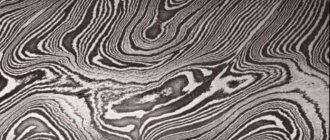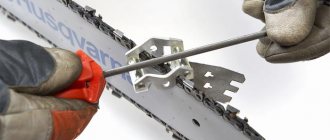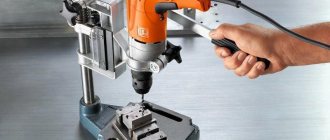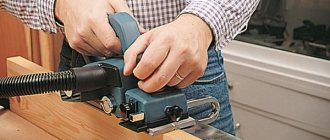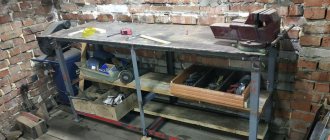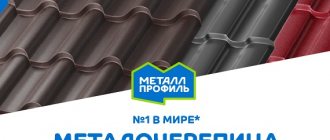Pruning and shaping plants is unthinkable without pruners. Only thanks to it can any cultivated plant be formed correctly without causing harm to it. Today the choice of pruners is simply huge. Garden pruners differ in blade shape, mechanism, handles, price and purpose. This article will tell you about the variety of types of pruning shears, their purpose and answer the question of how to choose the right pruning shears.
Components of pruning shears
As you may have guessed, the pruning shears do not have a whole set of elements.
The base sector consists of:
- Blade (working) – it is worth noting that this is one of the main parts. The blade is quite sharp and hard, which allows you to cut the necessary material evenly without injuring the remaining part of the plant. Keep in mind that the blade may become dull, so it will need to be sharpened over time.
- Blade (support) - this element is not sharp, since it is created for support - so that the plant juice does not create sticking in the pruner.
- Two handles - the handles are made from a certain material and always have the geometry of a human hand for convenient use. The material is preferably elastic, so as not to damage the skin of human hands.
All these elements are connected in a cross to each other, which is why they are very similar to scissors. The only difference is the spring added there for elasticity of movement.
Also, it is worth noting that some models have a kind of safety lock that helps keep the pruner in the closed position if you are not using it.
What it is
Grafting pruners are garden shears with shaped (various types) blades designed for making cuts on the rootstock and scion. Thanks to the unusual design, they are not only smooth and neat, but also perfectly match each other, like puzzles. The cambium of the scion and the wood of the rootstock fit as tightly as possible when they are combined. In this case, no additional adjustment is needed, which will only further injure the plants.
It is better to buy it complete with 3 different-shaped attachments:
- V-shaped;
- Ω-shaped;
- U-shaped.
The nozzles are sharpened steel knives, with which grafting plants ceases to be a problem.
Scope of application of pruners
Secateurs are one of the indispensable tools for the garden, especially the garden. The main purpose is to trim branches and bushes.
This is done for two purposes:
- Change of season - some plants require pruning in the fall or before winter, and pruning shears are an irreplaceable thing.
- Sanitary pruning – sometimes plants can be damaged by pests or infested, so pruning shears will do the job perfectly.
Secateurs are often used together with bush shears, and some gardeners even argue that these two elements cannot be replaced by anything.
Types of pruners
Secateurs have a variety of purposes, so it is necessary to study all types and their purpose in order to avoid incorrect use.
Let's look at the most popular types:
- The bypass pruner is a fairly classic tool, which is why it is often used for cutting living plants. Due to its correctly positioned blades, only the cut part of the plant is damaged.
- Contact pruning shears - the model is similar to the previous one. Designed for cutting dry branches. The handles of such a tool are curved, and the cutting part rests against the recess of the supporting blade.
- Pruning shears – this model is designed for cutting branches that are not very thick. It consists of two parallel blades. The tool looks like scissors.
- Floral pruning shears - designed for cutting thin shoots of flowers, usually used for pruning annual plants.
- Standard - a basic tool, both handles move simultaneously; the model has a spring that creates elasticity of movement. Used for pruning thin branches. Of course, with such pruning shears you can cut not only mesh, but also herbal plants, the only drawback is that the blade is not coated with a special coating that can protect the blades from sticking. Therefore, before choosing such a pruner, decide exactly what plants you will use it for.
- Reversible - it’s quite easy to understand how such a tool works, since the mechanism is called reverse.
- Secateurs with a protective arc - the arc protects your hands from damage.
Secateurs with an anti-stick blade - a special coating is applied to the blade, which does not allow the accumulation of juices from cut plants. This model is purchased for cutting mainly plants that release sap.
Size and weight
The issue is of fundamental importance primarily for women, since most instruments are still designed for a man’s hand. A “female” instrument should be approximately 20 cm long (or less) and weigh about 200 grams. Some manufacturers have secateurs of the same line in gradations in size and weight, so when purchasing, you can easily ask whether “there is the same one, but smaller.” Unfortunately, there is no standard for everyone: someone can mark their pruners as S, M and L, others have sizes indicated by numbers - and here you can’t do without the help of a sales consultant... From the outside, all these grams and centimeters seem insignificant, but if you work with pruning shears for several hours, it turns out that size really matters. It should be noted that all kinds of mechanism reinforcements (ratchets, levers, switches) and additional ergonomic elements inevitably increase the weight of the tool, so finding a model with the optimal balance of functionality and weight may take some time.
Criterias of choice
The first thing you should pay attention to is the sharpness of the blades. Take a piece of paper and run the blade of the pruning shears along it: if the blades “slide”, then the blades are well sharpened. In addition, if the pruning shears have removable blades, this is a big plus, otherwise, in order to sharpen the tool, you will have to disassemble the pruning shears.
- Secondly, when choosing pruners, it is important to pay attention to the cutting diameter, since there are models for small branch diameters that you cannot use to cut large-scale branches.
- Thirdly, you should pay attention to the material from which the weapon is made. For example, pruning shears are made from both steel and titanium. If you are choosing a tool for working with herbal plants that have the ability to release sap, give preference to pruning shear blades with Teflon or anti-friction coating, as it prevents the blades from sticking.
- Fourthly, look at the material from which the pen is made. It is extremely pleasant to work with rubber pads, as they do not injure your hands.
- Fifthly, if you need to work with plants that have thorns, it is better to choose pruners with extended handles that will not allow the thorns to scratch your hands. You can work with such models without gloves at all.
Cutting diameter
Everything is simple here: this is the thickness of the branches that the secateurs can handle. Self-respecting manufacturers must indicate this information in the description of the tool. It is believed that for pruning flower beds, shrubs and young tree shoots you need a pruner with a cutting width of 8-18 mm, and for mature fruit trees - 20-30 mm.
Different types of pruners
Photos of secateurs
Comparative table of products from the rating
| Name | View | type of drive | MAX cutting diameter, mm | Weight, kg | Price, rubles |
| Secateurs FISKARS PowerGear L РХ94 | planar | power | 26 | 0,24 | 3570 |
| Secateurs Mr.Logo 16740 | contact | ratchet | 24 | 0,24 | 1100 |
| Secateurs FISKARS SingleStep Р26 1000567 | planar | spring | 22 | 0,2 | 800 |
| Secateurs GARDENA B/S 8854-20 | planar | spring | 20 | 0,2 | 800 |
| Secateurs GARDENA B/S-XL 8905-20 | planar | lever | 22 | 0,3 | 2300 |
| Secateurs FISKARS SingleStep P25 1000564 | contact | spring | 22 | 0,19 | 1100 |
| Secateur Sibrteh 60495 | planar | spring | 15 | 0,2 | 400 |
| Secateurs Center tool titanium contact 0233 | contact | ratchet | 30 | 0,23 | 700 |
| Secateurs PALISAD 60503 | planar | spring | 15 | 0,14 | 300 |
| Secateurs SAMURAI IPSRC-55TA | contact | ratchet | 15 | 0,3 | 1000 |
| Secateurs Whirlwind 73/7/3/2 | contact | spring | 15 | 0,2 | 345 |
| Garden pruning shears GARDENA B/SM 8853-30 | planar | spring | 22 | 0,1 | 900 |
View the comparison table as a Google document
Sharpening
A sharpened blade made of good steel gives a beautiful, even cut, but sooner or later, it will still become dull. Sometimes the effect of a dull blade appears when a lot of juice has dried on it - you just need to wash it off with a warm disinfectant solution. If this does not help, then sharpening is required.
In the simplest version, you can sharpen the pruning shears with a file, but for a high-quality tool it is advisable to stock up on diamond stones. To prevent metal filings from clogging the abrasive, it is slightly moistened with water when working.
Start with the coarsest whetstone, sliding it along the blade from the handle to the sharp end, trying not to change its sharpening angle, which is usually 10–20°. Sharpen from the side opposite to the plane of contact of the blades, without touching it. The medium-sized bar is used to bring it to the desired sharpness, and the smallest one is used to remove burrs, including from the side where the blades touch.
Smooth blades are better
Any grooves, scratches or bumps on the cutting parts increase friction, make cutting more difficult and make wounds worse. The cutting parts must be well polished. Some models have Teflon coating applied to the blades, which improves glide and protects the metal from corrosion.
The blades of the new pruning shears must be absolutely smooth, without any defects.
Evaluate the strength of the blades
It directly affects durability. It is good if the cutting parts are made of strong and hard (hardened) steel: soft steel can wrap even after the first use and quickly becomes dull. It must be remembered that composite elements are less durable than solid ones, because during operation the pruner experiences greater mechanical stress. For myself, I excluded pruners with steel cutting pads, since they do not withstand intensive work for long. But for amateur gardeners whose annual pruning volume is small, they may be suitable.
Recommendations for use
Each instrument must be treated carefully. Care and necessary maintenance will allow the device to remain in working condition for a long time. A few simple rules of operation - a means to increase the service life of pruners:
- remove remnants of plant parts at the end of work;
- rinse the blades with running water to remove juice and resin;
- lubricate all moving mechanisms;
- do not leave on the site;
- sharpen in a timely manner if it becomes difficult to cut or when closing there is a gap between the blades;
- store in a room with a constant temperature and preferably in an open state;
- rinse and wipe dry before storing;
- Use only for the specified types of work.
Important! Collapsible secateurs are stored only in disassembled condition.
Gardeners perform various tasks with pruning shears. This tool differs in design and functions. From all the variety on sale, you need to choose the model that is most suitable for its intended purpose. All characteristics are taken into account: ergonomics, convenience, durability, functionality, etc. It is better to have several different devices - they will perform all tasks on the site. In order for the tool to last longer, the gardener needs to treat it carefully and maintain it in a timely manner.
Types of springs
Springs are necessary to return structural parts to their original position after compression.
- Wire - characterized by a short stroke and short service life. After some time, the spring relaxes and becomes loose.
- Lever - well adjusted to the required values, but very tight.
- Tape - they are called the most durable. It should be taken into account that during operation the link becomes clogged with various types of debris and begins to jam.
Don't be afraid of wire or lever models. If the product is made of first-class materials and the rules of operation and storage are not violated, then such a device will serve faithfully for a considerable time.
Pens
Responsible for ease of use. The most common options are metal, reinforced polyamide or plastic.
Metal ones are stronger. Such an element is often equipped with rubberized inserts so that the device does not slip out of your hands.
Plastic analogues also have rubber fragments. However, such parts often break and require careful handling because they can crack from impact. Polyamide options are much more solid than plastic, and therefore more preferable.
The shape of the handles must also be such as to minimize slipping. To do this, various protrusions for fingers and other irregularities are made on them. However, excessive “lumpyness” will interfere with long-term use, as it will put pressure and rub the palms. Some models have a ring handle to ensure you don't drop the item.
There are products with rotating handles - this is very convenient and allows you to reach vegetation in hard-to-reach places.
The bright color of the handles will help you not to lose the device in the grass.
Results
There are no universal rules for choosing a good garden pruner. There are only recommendations, otherwise you need to rely on your own feelings. The tool should fit comfortably in the hand, open and close smoothly and easily, and be securely fixed. The blades must be sharpened at the factory; it is difficult to do this yourself without experience. The presence of a Teflon coating will be a plus. As for the price, for 650–800 rubles you can buy a reliable and high-quality model, which, if handled with care, will last for many years.
Purpose
It will be useful for all gardeners to know that tools differ in their purpose. Of course, there are universal options that cope with a large number of tasks, but you should not expect from one product that it will perform all possible operations.
If you often do the same work related to pruning, then it is better to purchase specialized equipment for this operation.
Each field of activity involves the use of its own type of pruner:
- Floristry - thin and elegant objects, with two sharp blades of the same size, which are useful for cutting flowers and ornamental plants. They can also be used to cut various packaging materials: paper, film, tape.
- Lawn straightening – designed to trim the height of grass in hard-to-reach places that cannot be reached with a trimmer. The tip of such devices is made oblong and straight, and the distance to the ground is adjusted using a special wheel. There are models with short and long handles. In the second case, the cutting part is located perpendicular to the handle so that you do not have to bend over.
- Grafting is a special type of device responsible for creating a neat and level place for grafting. The same cut, only in a mirror image, is obtained on the grafted shoot. Due to this, the likelihood that the graft will take root increases, and the possibility of infecting the tree decreases.
- Brush cutters are garden scissors that have greater functionality and can handle cuttings up to 3 cm. Handles with a length of 20–40 cm allow them to be used in operations with thorny bushes, for example, for roses.
- Lopper - has long handles, like the previous variety, and a small but powerful cutting element with sickle-shaped blades. This design allows you to get rid of even cuttings 5–6 cm in diameter. Also, many people use them as an alternative to regular pruning shears, so as not to bend over during the cutting process.
- Verkhorez - necessary to trim branches located at a considerable distance from the ground. A telescopic handle is often built in for this purpose. There are also devices powered by batteries or gasoline. In fact, these are mini versions of electric chainsaws.
